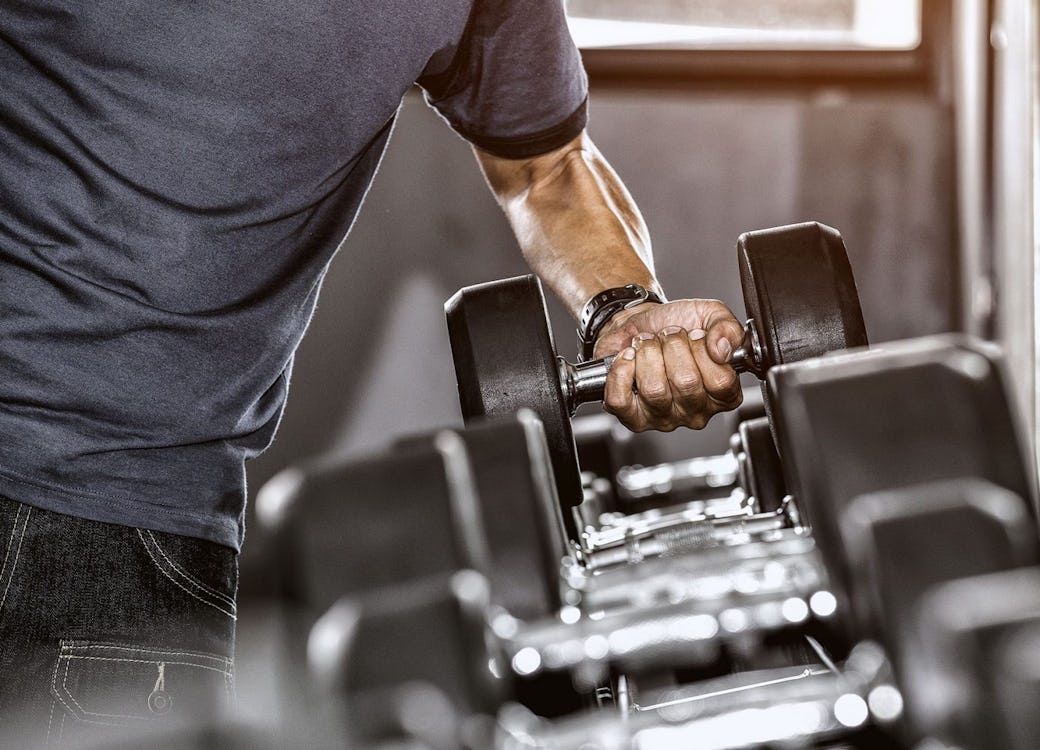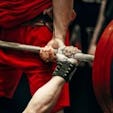Exercises that get you the most “bang for your buck,” as trainers like to say, are those that are efficient—working lots of muscles at once to net you big results for a relatively small time investment. The squat, deadlift, bench press, and other barbell lifts are usually cited as examples, but the dumbbell push press can rank up there too. For starters, it’s much easier to master. It’s also safer, gentler on the joints, and offers benefits for conditioning as well. We’ll go so far as to say that the dumbbell push press exercise ought to be in every lifter’s repertoire, from beginners to advanced athletes. Here’s how to do it right to build muscle and get ripped.
Key Takeaways
1. The dumbbell push press is efficient, working multiple muscle groups at once, including the deltoids, triceps, trapezius, forearms, core, quads, glutes, and hamstrings.
2. Incorporating the dumbbell push press can improve strength, power, muscle size, and conditioning for all fitness levels.
3. The dumbbell push press can be done for low reps for strength and power or high reps for muscle-building and conditioning.
How To Do A Dumbbell Push Press
Step 1. Hold a pair of dumbbells at your shoulders with one end of each dumbbell resting on your shoulders. Your palms will face one another, and the handles of the dumbbells should be parallel to the floor. Stand with feet about hip width and brace your core.
Step 2. Drop into a quarter-squat, initiating the descent by bending your knees and flexing your hips back slightly. Keep your head, spine, and pelvis in line so your back is flat and your eyes and head are forward. You don’t want to turn this leg drive portion of the lift into a squat, so only bend your knees enough to get some momentum, and don’t hinge your hips too much. Imagine yourself doing the move against a wall and sliding your torso up and down it—you should be that upright.
Step 3. As soon as you’ve dipped, extend your hips and knees explosively to stand up straight, driving through your heels, and simultaneously press the weights straight overhead. You’ll need to push from your shoulders and triceps, but with a strong and quick leg drive, most of the power for the press should be provided by your lower body. Keep your core tight throughout the move so your spine is stable and safe. Lower the weights back to your shoulders and drop your hips to immediately move into the next rep.
Benefits Of A Dumbbell Push Press
There are two major benefits to doing the dumbbell push press:
- Increased upper- and lower-body strength and power
- Improved conditioning
Ancillary benefits include improved core stability, and a strength and power carryover effect to Olympic weightlifting. In other words, if you perform snatches and clean and jerks in your workouts, and you add push presses into your routine as an assistance exercise, you’ll probably see benefits.
The dumbbell push press can’t be loaded as heavy as the barbell version of the exercise, but the challenge to your stability is greater, as you have to control two dumbbells moving overhead at the same time. And because your arms are free to move, rather than being fixed to a barbell and whatever path it may take when you lift it, your joints find the range of motion that’s best for them. In other words, the dumbbell push press is a safer, joint-friendlier push press.
James “Smitty” Smith, a strength coach and co-founder of the Certified Physical Preparation Specialist certification (and owner of Diesel Strength & Conditioning), says the exact gains you’ll see from the push press depend heavily on your “training age”—the number of years you’ve been lifting.
“For beginners using very light weight, there’s a great conditioning benefit,” Smith says. When you’re new to lifting, you don’t have the strength to train very heavy. (The weight may feel heavy to you as a newbie, but 25-pound dumbbells, for example, won’t cause the same kind of overall fatigue and muscle damage that the 60-pounders a more experienced lifter can use will.) Therefore, at this stage in your development, you’ll get more out of the push press doing it for high reps so that you challenge your endurance and conditioning. Smith notes that, “as you use leg drive to get them overhead, the dumbbells feel weightless during that drive phase.” Your shoulders aren’t really doing much work, so the push press won’t blow them up, but banging out lots of reps that work muscle from your legs on up will burn lots of calories and make your heart race.
On the other hand, more advanced lifters who can handle beastly weights can build even more strength and power with the push press, as well as gain conditioning. “That leg drive enables them to use heavier weights than if they were doing a strict overhead press without momentum,” Smith explains. And when you’re lifting, say, 60-pound dumbbells, you’ll be training heavy enough to feel your shoulders pushing that load, regardless of the help they get from your legs. “But your rack position is going to affect how much you can get out of the exercise.”
The rack position refers to the starting position of the push press, where the dumbbells are held at the shoulders while standing tall. This is the same basic starting position used for regular overhead presses, front squats, and many other moves that are derived from Olympic weightlifting (which the push press is), although there are a few variations of it. The best rack position for push pressing is the one explained above in the “How To” portion of this article: palms facing each other with the dumbbells parallel to the floor, and one end of each dumbbell resting on your shoulders.
A second rack position is dumbbells at shoulder level but with the palms facing forward. Most guys simply default to this without knowing any better because it’s how most guys would execute a strict overhead dumbbell press. Push pressing with palms facing forward isn’t necessarily wrong, but by using the same exact hand position as you’d be forced to use during a barbell push press, you’re losing the best benefits of doing this exercise with dumbbells—shoulder safety and range of motion. The first rack position with palms facing each other is much easier on the shoulders, because it allows the humerus bones to move more freely through the shoulder joints. There’s more risk of impingement over time with palms-forward pressing—especially for guys who already have tight shoulders, or who carry a lot of upper-body mass. When the dumbbells are held with a neutral grip, it’s also much easier to get them to rest on your shoulders, giving you a little extra distance to press for greater muscle activation.
Palms-forward can also be “a much weaker postion,” according to Smith, due to the fact that a lot of guys are so tight they can’t get the weights to rest on their shoulders, and instead have to work to control the weights in space throughout the exercise (i.e., held slightly in front of the shoulders). This not only fatigues the shoulders much faster, but oftentimes causes the weights to sway back and forth as you do reps, banging into the shoulders and making it harder for you to keep position or press safely.
Still a third rack position exists: holding a single dumbbell, T-boned against the shoulder while the lifter leans away from the weight (see below). This position is often used by strongmen when the competition event is pressing a circus dumbbell or other odd-shaped weight overhead. With this rack position, you press one side at a time, using more of the upper body.
How Do I Use The Push Press In My Workout?
If your goal is to build power for athletics or to improve your ability to do other Olympic lifts, Smith says to place the dumbbell push press first thing in your workout, right after your warmup and before any other strength training sets. With all your muscles fresh and primed, you’ll get the best gains in power by placing it there. See “What Muscles Does A Push Press Work?” below for a better understanding of how the dumbbell push press works to build power.
A classic set and rep range for building power would be a relatively higher number of sets, say 6 to 7, with a relatively low number of reps, such as 2 to 4.
If your goal is more geared toward conditioning, or you’re a relatively inexperienced lifter, you can place the dumbbell push press toward the end of your workout, after your strength training sets. For this purpose, you could do 3 sets of 15–25 reps, and you might want to use it as part of a dumbbell circuit where you perform other exercises that can flow together with the push press, such as a bent-over row, Romanian deadlift, and dumbbell clean.
The push press can also be used as a way to cheat out a few extra reps on strict overhead presses. Toward the end of a set, when you feel you can’t do any more regular presses with good form, you can switch to push presses and eke out a few more reps, thoroughly frying your shoulders. The push press can work at the beginning of a set, too. If you’re coming back from a shoulder injury, and you want to do overhead presses but reduce the strain on your shoulders in the bottom position, you can get the weight moving by doing a push press on the first rep. In other words, the first rep won’t begin from a dead stop on your shoulders, which puts a lot of stress on your shoulder joints. As you lower that first rep to completion and begin the next rep, the stretch reflex will kick in—your delts feel like they’re being stretched, potentially into a dangerous position, and so they’ll contract harder to help you lift the weight. Your joints won’t have to “shoulder” as much of the load.
What Muscles Does A Dumbbell Push Press Work?
The push press exercise is, very simply, a standing overhead press done with momentum from the lower body. Holding the dumbbells at your shoulders, you quickly dip and then extend your hips and knees to get the weights moving upward, and then you lock out your elbows with a pressing motion. Because it’s pretty much a full-body effort, the dumbbell push press incorporates several major muscles in the upper and lower body. They are:
Glutes. Your butt muscles are the prime movers during the quarter-squat portion of the exercise. They help flex the hips during the descent and then explosively extend the hips to generate the power that propels the dumbbells overhead.
Hamstrings. They bend the knees in a controlled manner as you dip, and work synergistically with the glutes to extend the hips on the way up.
Quads. The thigh muscles stabilize the knees as you squat and work to extend them when you come up.
Core. The rectus abdominis, obliques, and spinal erectors all work to stabilize the spine and keep it in a safe, neutral position. The heavier the load, the more your core musculature will be recruited.
Deltoids. The prime mover when driving the weights overhead, the delts are responsible for flexion and rotation of the shoulder joint. If you’re push pressing lighter weights with a powerful leg drive, their role is secondary to that of the leg muscles in this exercise, but still vital. When doing heavy push presses, their role increases.
Trapezius. The muscle that makes your neck look yoked stabilizes the upper back and shoulders. It’s also responsible for stopping you from slumping out of good posture during the lift, rounding your shoulders forward.
Triceps. The tris work with the deltoids to extend the arms overhead, locking out your elbows.
Forearms. Any time you’re holding a barbell or dumbbell—or just squeezing your fists hard—the forearms are working. In this case, the wrist flexors and extensors stabilize the wrists throughout the exercise.
How To Stretch Before The Dumbbell Push Press
Onnit Durability Coach Natalie Plascencia (@natalie.higby on Instagram), offers these two mobility drills to increase range of motion and stability in your shoulders and upper back before you perform the push press.
Alternatives To The Dumbbell Push Press
Three exercises that can produce a similar training effect to the dumbbell push press are:
Med-Ball Chest Pass
Throwing a ball for height mimics the push press. In CrossFit parlance, this is known as a “wall ball shot.” Like the dumbbell push press, it’s a pressing motion and it involves leg drive—but from a much lower position. The implement used, however, leads to some key differences. First, the med ball must be held at the chest, meaning your arms are working hard throughout the exercise to support the ball (it’s not resting on your shoulders like dumbbells do in a push press). Second, the ball is released at the top of the move and thrown for maximum height. Some additional work is required as well, as you either have to catch and stabilize the ball as it falls, or gather it up after it hits the ground.
Pentagon-Bar Push Press
This five-sided bar with rotating handles (picture the front half of a trap bar) plugs into a landmine unit and does for overhead moves what the trap/hex bar did for deadlifts and shrugs. The load is perfectly balanced around you, and somewhat stabilized by the base of the landmine unit. The video below will show you how to do a strict overhead press with the Pentagon bar. Just add leg drive to do a Pentagon bar push press
Dumbbell or Kettlebell Snatch
Like the dumbbell push press done with light weight, most of the power for this move is provided by the lower body. When done right, the shoulder acts in a stabilizing capacity—not to press the weight overhead. Just be careful: technique is key and mastery is required to gain maximum benefit and to stay safe.
Don’t forget to explore our guide on the kettlebell snatch.
Also, make sure to check out our guide to a similar exercise, the dumbbell clean and press.

)





